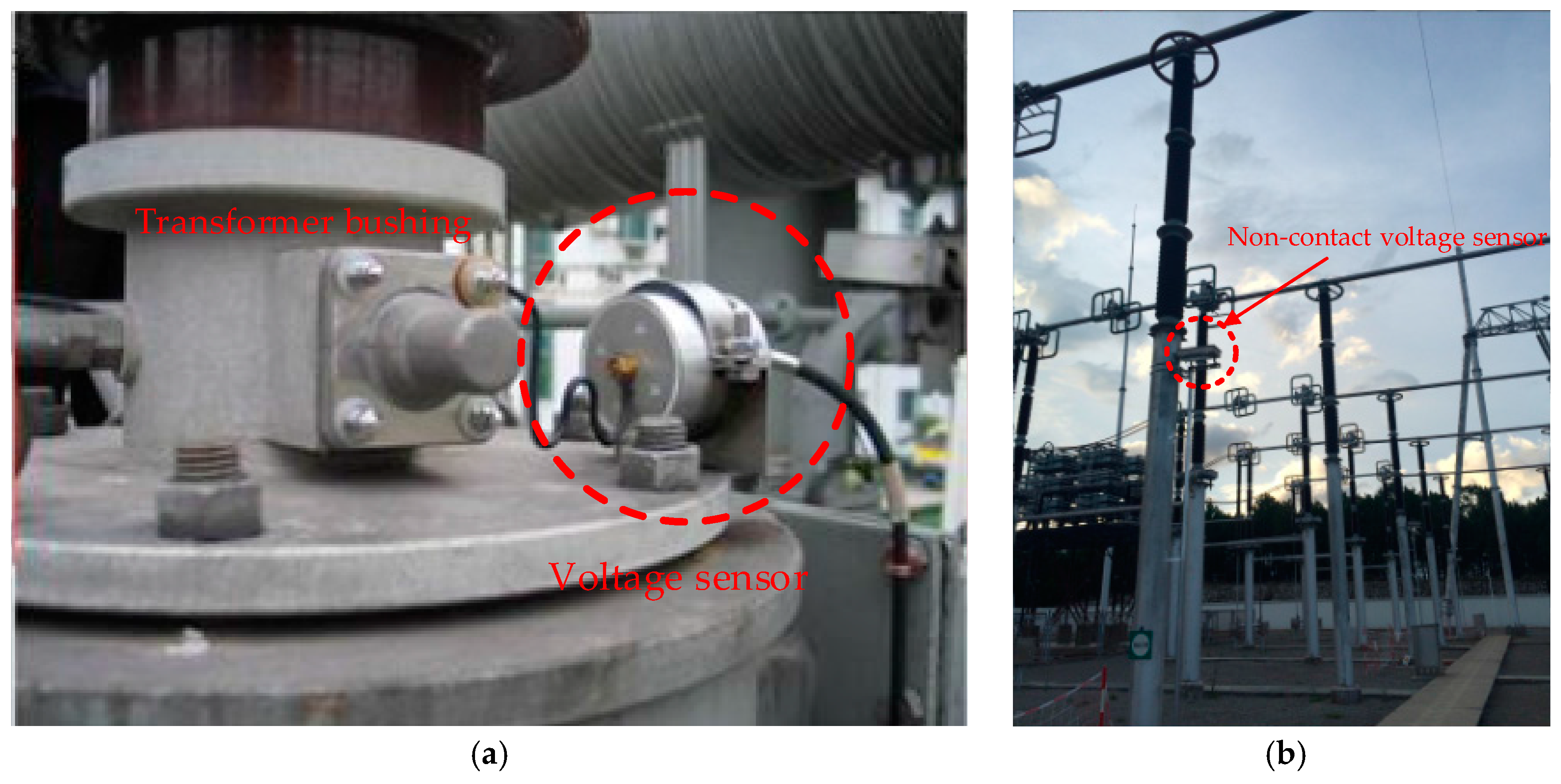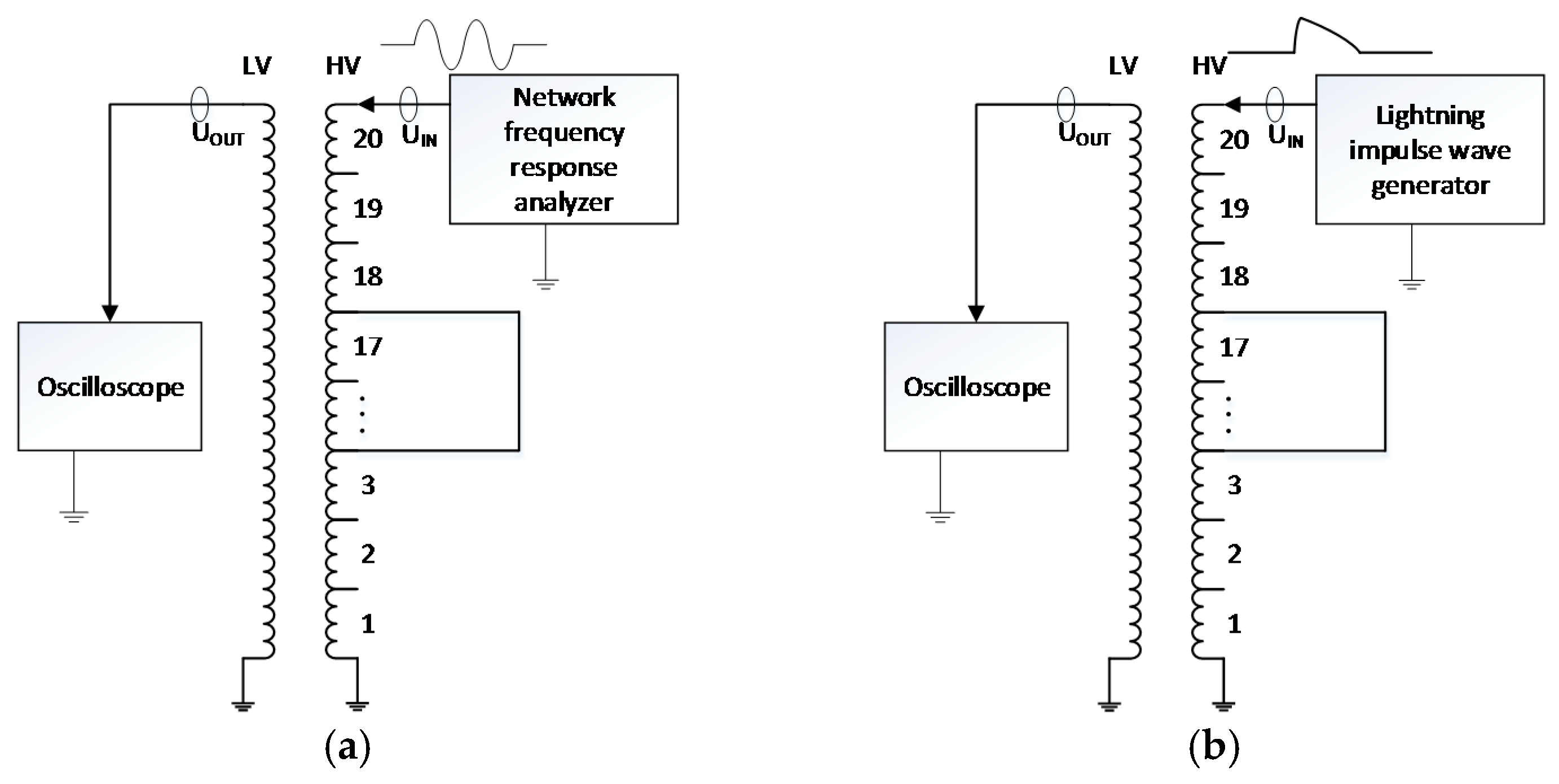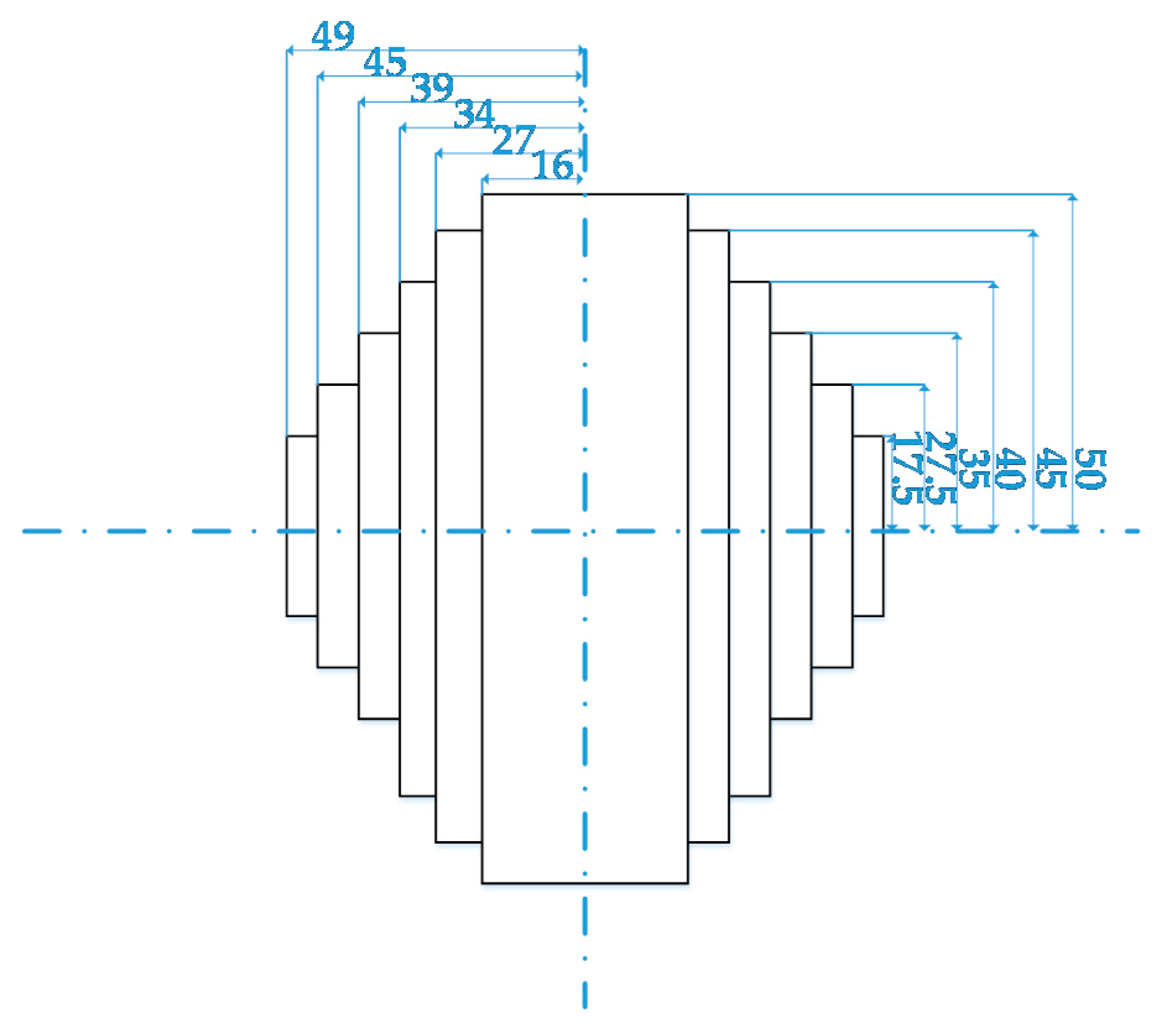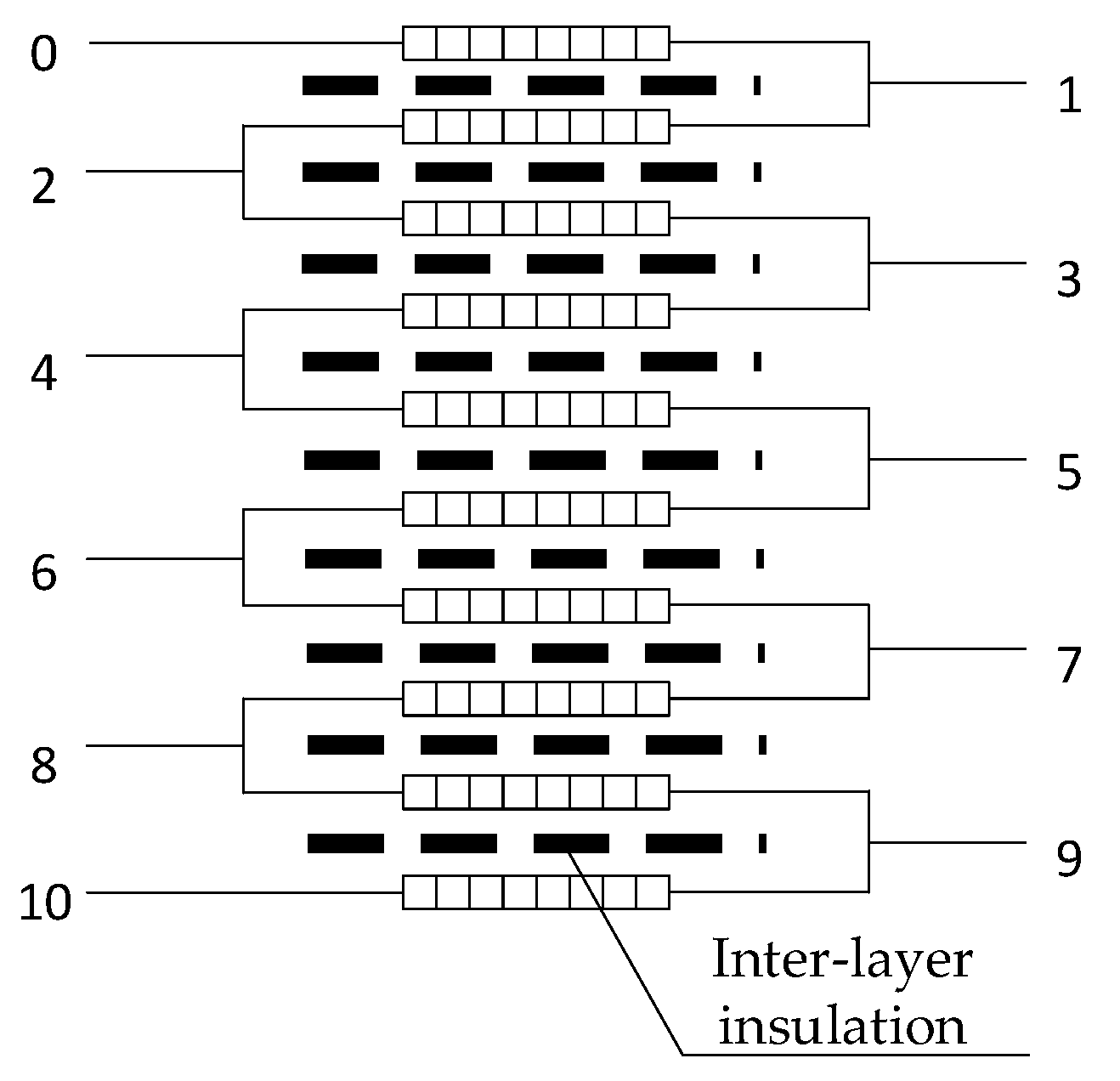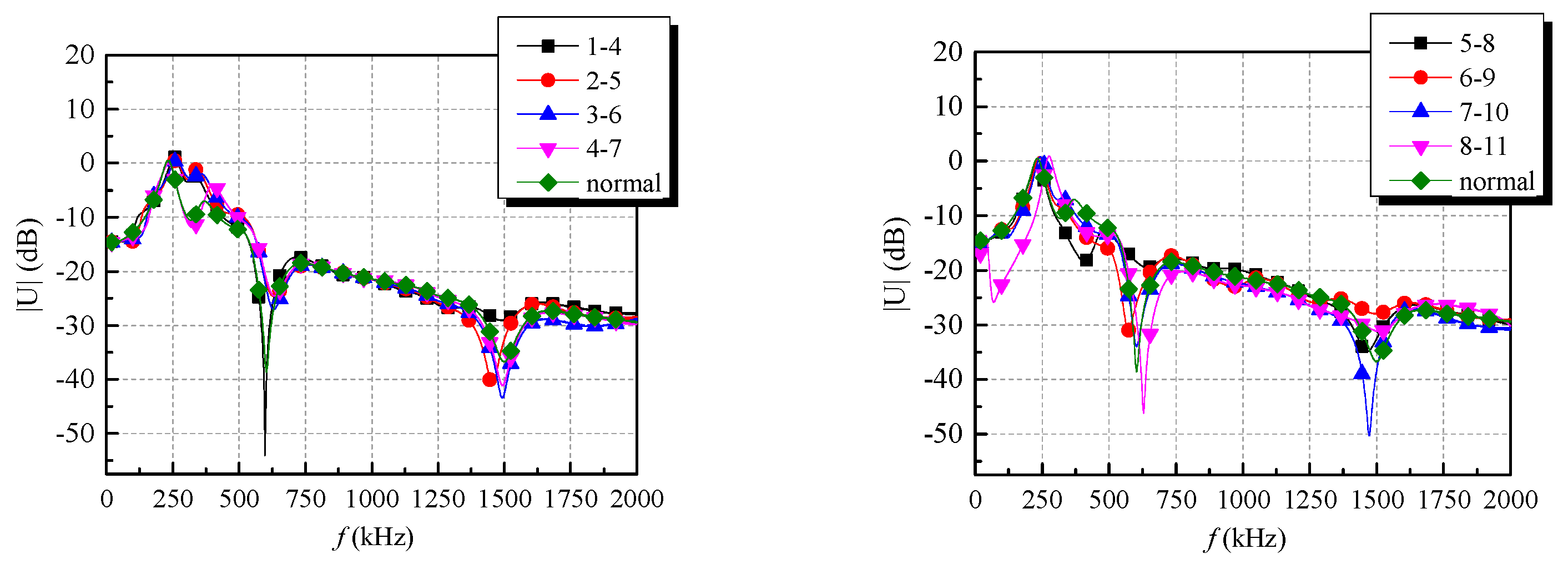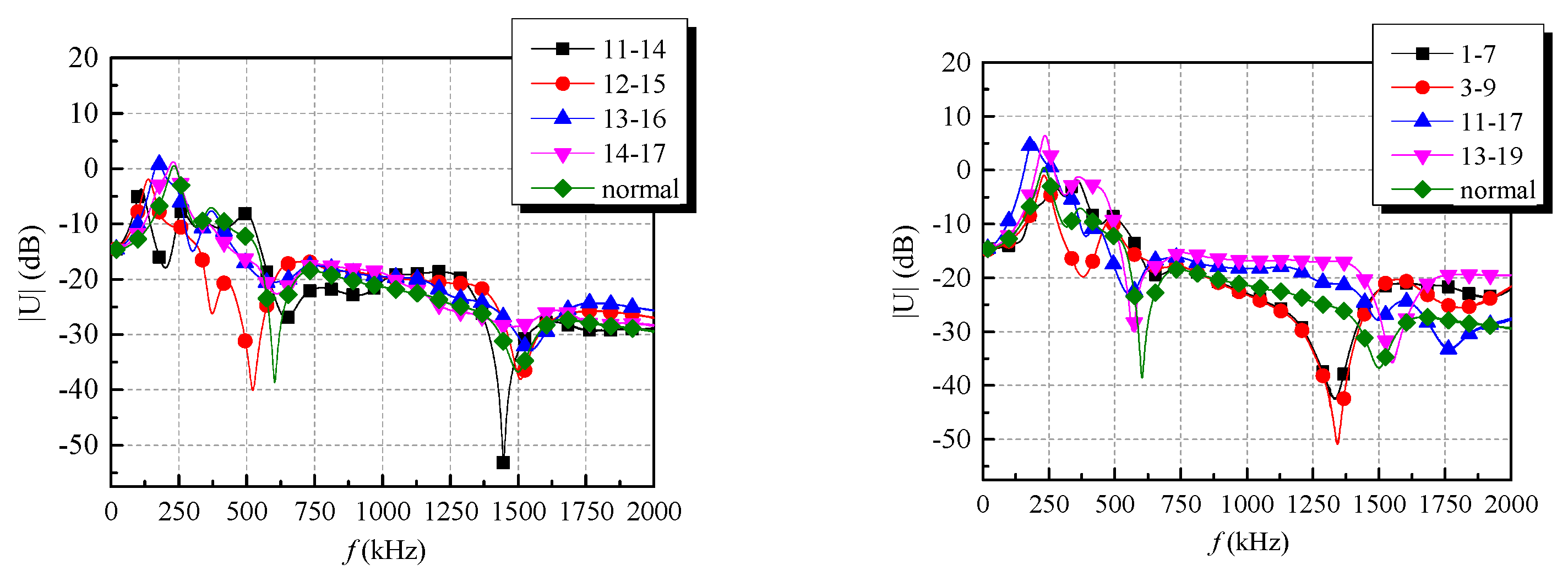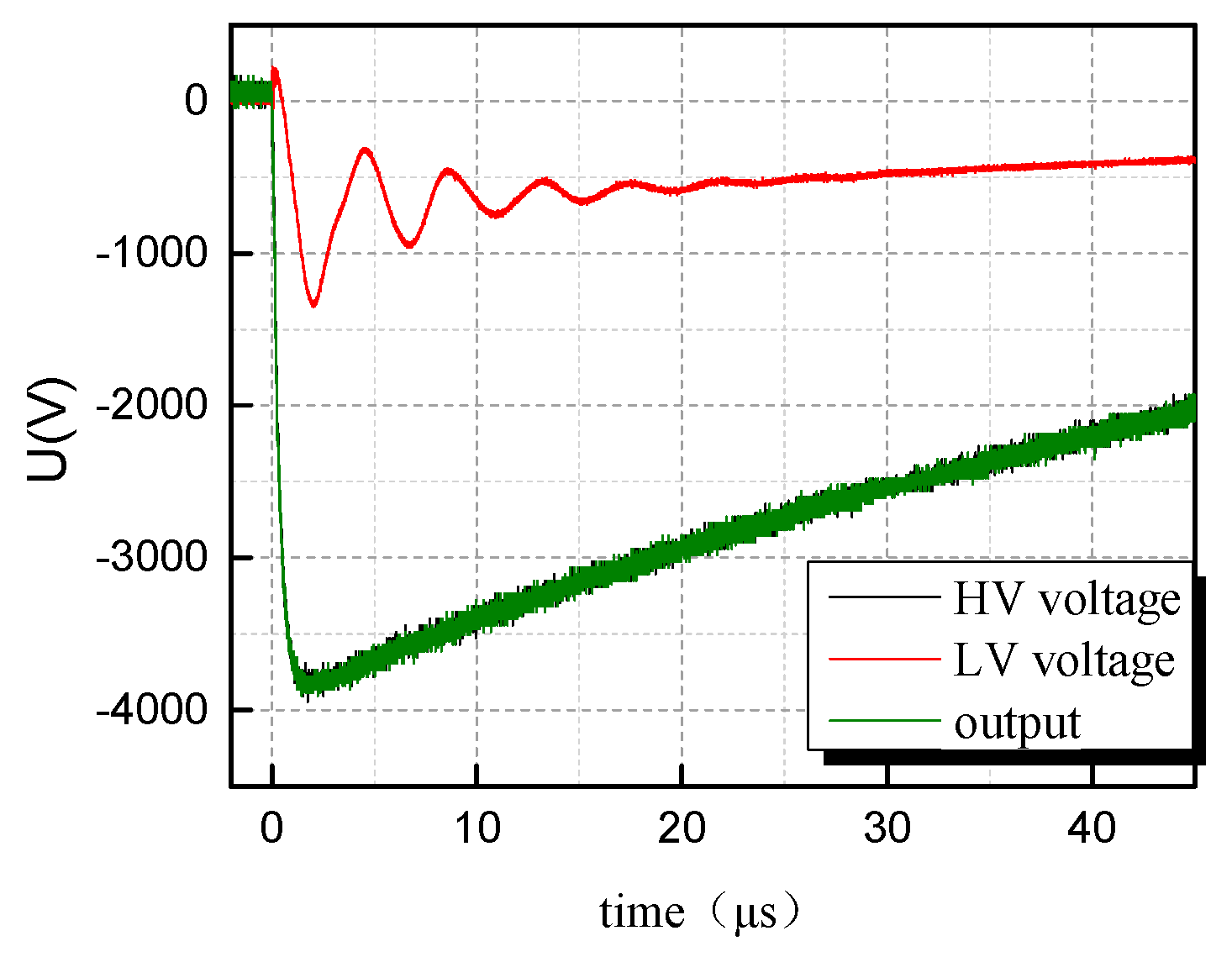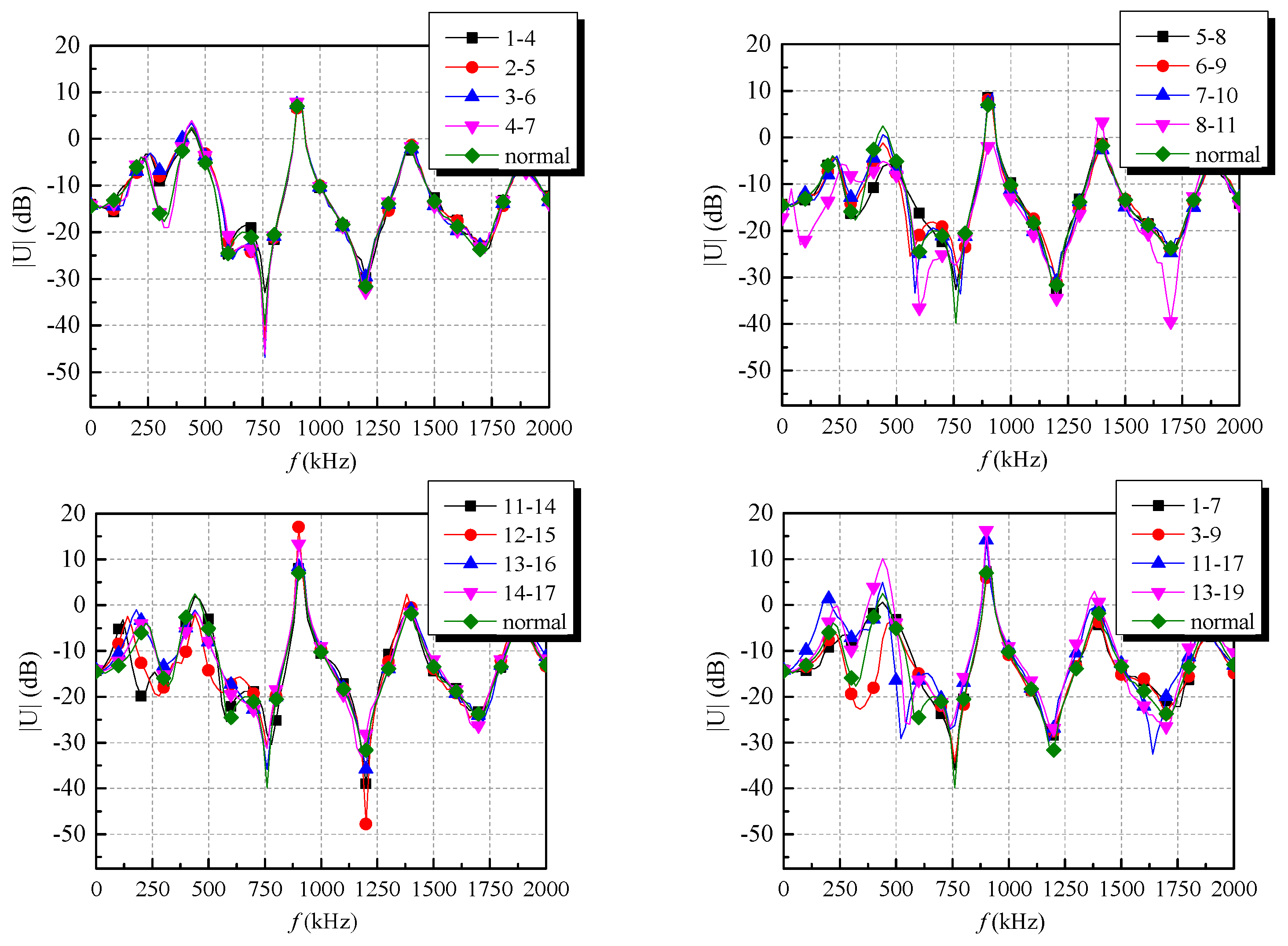1. Introduction
Power transformers are recognized as one of the most important transmission components in the operation of the power system. Their stability and reliability ensure safe operation of the entire system: once transformer malfunction occurs, the transmission ability of the power system faces a significant threat. Malfunction of long-term transformers often occurs owing to the impact of transient overvoltages. According to [
1], statistics show that between 70–80% of the number of total transformer failures are eventually traced back to undetected internal winding faults. Winding faults are a result of severe deterioration of the turn insulation, which tend to cause a breakdown in the dielectric strength of the insulation. This breakdown can cause adjacent windings to short (turn to turn) or a winding to be shorted to ground. Typical transformer failures, such as winding-ground short-circuit and winding interlayer short circuit, seriously damage the internal insulation [
2] and affect normal operation. Safety and stability of transformer operation is becoming increasingly important because of the rapid development of ultra-high voltage technologies. It is therefore of significance to detect the existence of transformer faults that can avoid the occurrence of larger power system failures.
Diagnosis of transformer winding faults is usually carried out by testing [
3,
4] and then simulation [
5,
6]. Use of finite-element simulation software to simulate the structure of the core [
7] and winding, or other real-time electromagnetic field distribution to determine the state of the winding, can determine whether the transformer is functioning normally [
8]. Simulation methods can detect winding faults, but lack of operating data limits their practical use. Commonly used winding-fault diagnosis methods require outage of the transformer before testing [
9]. There are several common methods including low-voltage impulse testing (LVI) [
10], short-circuit impedance measurement method (SCI) [
11], frequency response analysis method (FRA) [
12,
13], partial discharge method (PD) [
14] and dissolved gas-in-oil analysis method (DGA) [
15]. Using DGA, the relative concentration of various gases in the transformer oil is analyzed to detect transformer winding fault. PD occurrence has been known to produce several types of signals such as electromagnetic wave, sound wave and light, which can be analyzed to diagnose transformer winding fault. However, these tests cannot detect an incipient winding turn to turn fault very fast [
16]. FRA is most frequently used to assess the state of windings [
17], such as deformations and turn to turn short-circuit [
1,
16], by measuring their broad-spectrum frequency response transfer function. FRA can be divided into two main types, based on the different signals injected into the transformer: sweep frequency response analysis (SFRA) [
18,
19,
20] and impulse frequency response analysis (IFRA). SFRA is commonly used for offline tests after a transformer failure and is hardly sufficient for preventing transformer failure. Therefore, if IFRA is used as the offline test, the applied impulse voltage should be in accordance with the insulation strength of the transformer. Because the impulse duration is very short, which would not influence the normal operation of the transformer noticeably, IFRA is feasible for online application.
FRA can be used to evaluate the state of a winding by mathematically comparing the transfer function [
21,
22] curves under normal and fault conditions and determine the type of fault using the correlation coefficient [
23] and other statistical indicators. The exciting signal injected by SFRA is a series of sweep signals at different frequencies and a voltage amplitude of several volts; the exciting signal of IFRA is an aperiodic impulse that contains multi-frequency components and a voltage amplitude of several hundred volts. These injected signals may influence the core remanence and obtained data that cannot describe the situation of the windings, leading to inevitable errors. Moreover, these FRA methods need an external pulse or impulse signal generator to conduct the tests. A method for online FRA was put forward [
24], in which the signal is injected from the bushing tap by a capacitor, and the response is measured at the neutral point. This method was used offline for detecting a transformer failure in laboratory. Injecting a signal into a bushing tap may cause an insulation fault, which is unaccepted for an operation transformer.
Lightning, operating impulse, and other transient overvoltages occur widely in actual power grids [
25]. The overvoltage signal has broad-spectrum characteristics, which makes it possible to be used as an exciting signal for diagnosis of permanent winding faults [
26]. Moreover, compared with traditional FRA, the overvoltage signal has greater amplitude and can avoid the insulation failure caused by signal injection. Therefore, if the overvoltage signal can be monitored, it is possible to use this as the exciting source and calculate the transfer function by monitoring the corresponding voltage or current signal of the winding. Transformer faults can therefore be evaluated by comparing their transfer functions under normal and fault conditions. Moreover, use of a transient overvoltage with greater amplitude could demonstrate the real operating performance of a transformer, thereby realizing online fault diagnosis of transformer winding faults based on overvoltage monitoring.
In recent years, we have invented a series of transient overvoltage sensors, such as the bushing capacitive divider and non-contact overvoltage monitoring system [
27,
28], that are applied to operating power systems, as shown in
Figure 1. Transient overvoltages at the high-voltage (HV) and low-voltage (LV) windings can be monitored. These sensors make the monitoring of transformer winding insulation using transient overvoltages possible. Unlike SFRA and IFRA, the voltage level of such transient overvoltage signals applied to a transformer can be of the order of kilovolts; the impulse wave method was therefore selected for the experimental testwork. The impulse wave method uses a transient overvoltage signal, which can be obtained by sensors of the overvoltage monitoring system as the exciting signal to diagnose the transformer winding faults, and has the potential for online application. Because voltage sensors are normally set on both sides of the transformer winding when they are installed on the real transformer, the transient voltage data is the most convenient to be acquired in the field tests. Thus, the voltage transfer function is selected to evaluate the impulse wave method. This uses a lightning impulse with high amplitude voltage as the excitation signal from which the voltage transfer function is obtained. Therefore, in this paper, to find out the transient overvoltage response performance of a transformer, in order to widen the application of overvoltage monitoring, it could also present a feasible method for transformer winding fault diagnosis based on overvoltage monitoring. Therefore, to verify whether the impulse wave method can diagnose the occurrence of transformer winding fault, the winding-ground fault and the interlayer-winding fault are selected to figure out whether the sensitivity of the impulse wave method is similar to that of the SFRA method. The impulse wave method, using a lightning impulse of 4 kV as the exciting signal, is compared with the common SFRA method by measuring the winding voltages under normal and two fault conditions. The transfer functions under different faults conditions are calculated and then analyzed using statistical indicators to describe the differences between two curves. For the transformer winding used in these experiments, it is found that the sensitivity of the impulse wave method is similar to that of SFRA under conditions of winding-ground and winding-interlayer short-circuit faults. The results demonstrate that the impulse wave method could be feasible for online diagnosis of transformer winding faults.
5. Comparison of SFRA and Impulse Wave Methods
The fault diagnosis of transformer windings can be realized by analyzing the differences of the transfer function curves under normal and fault conditions. To quantitatively analyze the difference between the voltage transfer function under normal and malfunctioning conditions, three statistical indicators are used. The change of statistical indicators under different types of transformer winding faults is presented when the voltage transfer function curves are obtained in the tests. These three indicators are the correlation coefficient, the absolute sum of logarithmic error and the spectrum deviation. The description of the shift of the resonance points is also presented. Since the amount of the resonance points under the impulse wave method is more than that under SFRA, it is hard to find out the characteristics between the shift of the resonance point and the faults. The correlation coefficient
ρ(
X,
Y), spectrum deviation
σ(
X,
Y) (
DELTA), and the absolute sum of logarithmic error (
ASLE) are, respectively, defined as:
where vectors
X = (
x1,
x2, …,
xn) and
Y = (
y1,
y2, …,
yn) denote data vectors of the two frequency responses and
n is the number of frequency points. These indicators can convert a graphical depiction into a change of value that can directly indicate whether a fault has occurred. The spectrum deviation
σ(
X,
Y) approaches zero and the correlation coefficient
ρ(
X,
Y) approaches 1 when the shapes of
X and
Y are similar to each other;
ASLE is very useful in terms of representing a logarithmic vertical axis.
Figure 13,
Figure 14,
Figure 15 and
Figure 16 compare these three statistical indicators for the SFRA and impulse wave methods under conditions of winding-ground and single-, three-, and six-interlayer-winding faults.
The correlation coefficient of the SFRA method is slightly larger than that of the impulse wave method under the same conditions for all fault cases. As changes of location of the winding-ground and interlayer-winding short-circuit faults occur, the overall trends of the correlation coefficients for both methods are similar. In the case of winding-ground faults, the correlation coefficient decreased with increase of tap number, which means that the smaller the correlation coefficient, the more severe is the fault. In the case of winding-interlayer short circuits, changes of correlation coefficients are related to changes in fault location and have no direct correlation with the severity of the fault. When taps 12 and 13 are metal-connected, the correlation coefficient is smallest.
Considering the DELTA values, the two methods are similar. Under winding-ground conditions, DELTA of the impulse wave method increases when the fault location approaches the HV ending at tap 20, which means that the severity of such faults can be indicated by DELTA from the impulse wave method. For interlayer short-circuit faults, the DELTA values of both methods have their own patterns with respect to changes of position of the fault.
Considering ASLE, the trends for the two methods are the same, with the values of SFRA being larger. In both cases, the ASLE could indicate the severity of a winding-ground fault, but not of an interlayer fault.
The correlation coefficients of the voltage transfer function of the winding-ground fault obtained by the SFRA method and the impulse wave method are both less than 0.99. In addition, the correlation coefficient of the voltage transfer function of the winding-ground fault obtained by the SFRA method and the impulse wave method are both less than 0.98. It can also be found out that the statistical indicators present the same level at magnitude under the same winding fault conditions for both of the two test methods. The sensitivities of the impulse wave and SFRA methods to winding-interlayer short-circuit faults are quite similar for the transformer windings used in this experiment; however, the SFRA method could better determine the severity of winding-ground short-circuit faults. This is because SFRA will commonly apply a frequency range of 1 kHz to 1 MHz to the transformer; however, the frequency response of the impulse wave method can approach 10 MHz. As
Figure 10,
Figure 11 and
Figure 12 show, the differences between transfer function curves mainly occur at frequencies below 1 MHz: the first and second resonance points shift obviously, but there is little change in the others.
The transformer windings can be considered as a passive two-port network—the equivalent circuit of which consists of resistors, capacitors, and inductors, as shown in
Figure 17. The two sides of the windings are represented by a ladder network in the equivalent circuit, comprising a series of inductances
L1 and
L2, series capacitances
CS1 and
CS2, shunt capacitances
Cg1 and
Cg2, and mutual inductances
MIJ,
Mij, and
MIj. The resonance for the impulse wave method and the SFRA method depend on the value of all of these capacitances and inductances, which are affected by the winding itself and the transformer structure. Therefore, the resonances obtained by the two methods are both related to the intrinsic resonance characteristic of the transformer. When the frequency is below 1 kHz, the response characteristic is affected by the winding resistor, which creates fewer resonance points and is less sensitive to changes of distributed capacitance of the transformer winding; when the frequency is above 1 MHz, the inductance is seen as short-circuited by the distributed capacitance, which makes it insensitive to changes of inductance.
Because the HV winding is divided into two cylindrical sections, the injected lightning voltage wave could reflect in the winding and refract at the tap where the voltage waveform is acquired. This could cause abnormal distortion of the waveform and decrease the resolution of the impulse wave method. Another reason for the unusual changes of the transfer functions in
Figure 14,
Figure 15 and
Figure 16 could be wave reflection in the transfer winding. The SFRA method avoids the influences of reflection and refraction.
The shunt effect of the transformer winding-to-ground and inter-winding stray capacitances causes uneven transient voltage distribution. A higher voltage can more clearly reflect slight changes of winding voltage transfer under transient voltages, indicating the state of the transformer core more clearly and accurately compared with a lower voltage. Changes of the transfer function after FFT can also more clearly distinguish the severity of a short circuit.
Moreover, in the real application of the impulse wave method based on transient overvoltage monitoring, the shape of the voltage applied on the transformer may be varied. In order to determine the effect of the shape of the applied voltage shape on the sensitivity of the impulse wave method, three lightning voltage wave shapes were selected to be applied to the tests under the single interlayer-winding fault condition. These three waves have the same wave tail time of 50 μs, but the wave front time is 0.2, 1.2 and 5 μs, respectively. The statistical indicators for transfer functions for the SFRA and the impulse wave methods with front time of 0.2, 1.2 and 5 μs under single-interlayer-winding fault conditions are shown in
Figure 18.
It can be found by the comparison among the test results shown in
Figure 18 that the shape of the applied impulse voltage could affect the response of the applied voltage. However, it can also be found that the statistical indicators show the same level at magnitude for the impulse wave method under three different applied lightning voltage wave shapes and the SFRA method, which shows that the impulse wave method could be applied to diagnose the winding fault even if the impulse voltage applied to the tests is not the standard lightning voltage. It should be noted that when the 5/50 μs lightning voltage is applied to the tests, the sensitivity of the impulse wave method is less than that when 0.2/50 μs and 1.2/50 μs lightning voltage are applied to the tests. This is because the impulse wave method relies on the frequency response. The high frequency part is dominant for the sensitivity of the method.
By measuring the voltages in the HV and LV windings, the voltage transfer function can reflect the transfer characteristics between the two windings. Moreover, if the transient current data can be obtained simultaneously in real applications, the admittance transfer function or ∆U/∆I can be obtained, which is helpful to evaluate the faults along with the voltage transfer function. In our future work, the admittance transfer function or ∆U/∆I would be investigated in our laboratory and field tests.
Since the SFRA method has already been applied to field tests, we believe the impulse wave method could also diagnose the transformer winding fault to some degree based on the test results and analysis. The SFRA test is an offline test, which needs additional exciting signal sources to be injected into the transformer. This may be avoided if the impulse wave method could be applied to diagnose the winding fault and the overvoltage monitoring system is applied to the transformer. However, in the real application of the impulse wave method, it is necessary to consider the electromagnetic interference of the environment. Furthermore, in order to apply this scheme to larger transformers, coupling effects of three phases and magnetic circuit asymmetry must be considered. To extend this scheme to larger transformers, coupling effects of three phases and magnetic circuit asymmetry must be considered. A test platform based on a three-phase transformer will be assessed in the next stage of this research. In addition, the impulse wave method will be further verified in actual applications by long-term observation of the overvoltage monitoring system of Chongqing University in the real power transformer.
